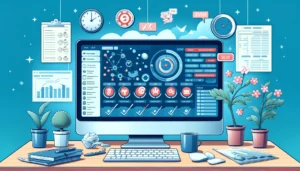Managing Remote Employees

Establishing Clear Communication Channels
In the realm of managing remote employees, establishing clear communication channels is paramount. Effective communication serves as the backbone of remote work, ensuring that all team members are aligned and informed. Companies like Deskcove understand the importance of seamless communication and have integrated various tools to facilitate this process.
First, utilize multiple communication platforms to accommodate different types of interactions. Email is suitable for formal communication and documentation, while instant messaging apps like Slack are ideal for quick, real-time discussions. Video conferencing tools such as Zoom or Microsoft Teams are essential for face-to-face meetings, which help build rapport and reduce misunderstandings.
Second, set regular communication schedules. Daily check-ins, weekly team meetings, and monthly reviews can create a rhythm and routine that remote employees can rely on. This ensures that everyone stays connected and on the same page, even when working from different locations.
Best Practices for Communication
- Choose the right communication tool for each purpose
- Establish clear guidelines for communication frequency and response times
- Encourage open and honest communication to foster a supportive environment
Setting Expectations and Goals
Setting clear expectations and goals is crucial in managing remote employees. This process begins with a comprehensive onboarding program that outlines the company’s objectives, values, and performance standards. New hires should understand their roles and responsibilities from the outset.
Define measurable goals using the SMART criteria (Specific, Measurable, Achievable, Relevant, Time-bound). This method provides clarity and direction, making it easier for remote employees to understand what is expected of them. Regularly review and adjust these goals to ensure they remain relevant and aligned with the company’s evolving needs.
Additionally, provide detailed job descriptions and performance metrics. This transparency helps remote employees gauge their progress and identify areas for improvement, fostering a culture of accountability and continuous improvement.
Strategies for Setting Expectations
- Conduct comprehensive onboarding sessions
- Utilize SMART criteria for goal-setting
- Regularly review and adjust goals to stay aligned with company objectives
Building Trust and Accountability
Building trust and accountability is a cornerstone of successful remote employee management. Trust is built through consistent, transparent communication and by demonstrating reliability and integrity. Managers should lead by example, showing commitment to their work and to their team members.
Encourage autonomy by giving remote employees control over their work schedules and tasks. This empowerment boosts morale and productivity, as employees feel trusted and valued. Establish accountability by setting clear deadlines and holding regular progress reviews.
Recognition and reward systems also play a vital role in building trust. Acknowledge accomplishments and provide constructive feedback to reinforce positive behaviors and address any issues promptly. This balanced approach helps maintain high performance and fosters a supportive work environment.
Methods to Build Trust
- Demonstrate reliability and integrity
- Empower employees with autonomy
- Implement recognition and reward systems
Utilizing Project Management Tools
Project management tools are indispensable in managing remote employees. These tools streamline workflows, enhance collaboration, and provide visibility into project progress. Deskcove leverages various project management platforms to ensure seamless coordination among remote teams.
Platforms like Trello, Asana, and Monday.com offer intuitive interfaces for task management, allowing teams to assign tasks, set deadlines, and track progress in real-time. These tools also facilitate communication through integrated messaging and comment features, reducing the need for excessive email threads.
Moreover, these tools offer analytics and reporting features that provide insights into productivity and project timelines. This data-driven approach enables managers to make informed decisions and adjust strategies as needed to keep projects on track.
Key Project Management Tools
- Trello for visual task management
- Asana for comprehensive project tracking
- Monday.com for team collaboration and workflow automation
Fostering Team Collaboration and Engagement
Fostering team collaboration and engagement is essential for the success of remote teams. Creating a collaborative environment helps remote employees feel connected and part of the larger organization. Deskcove prioritizes team building activities and collaborative projects to enhance team cohesion.
Use virtual team-building activities to strengthen relationships. These can include online games, virtual coffee breaks, and collaborative challenges. Regular social interactions help build camaraderie and trust among team members.
Encourage collaborative projects that require input from multiple team members. This approach not only fosters teamwork but also leverages diverse skills and perspectives, leading to more innovative solutions and better outcomes.
Ways to Enhance Team Collaboration
- Organize virtual team-building activities
- Encourage collaborative projects and brainstorming sessions
- Provide platforms for social interaction and engagement
Providing Regular Feedback and Support
Providing regular feedback and support is critical for managing remote employees effectively. Continuous feedback helps employees understand their strengths and areas for improvement, promoting professional growth and development.
Schedule regular one-on-one meetings to discuss performance, address concerns, and provide guidance. These sessions should be constructive and focused on helping employees achieve their goals. Use performance metrics and examples to provide specific, actionable feedback.
Offer support through professional development opportunities, such as training programs, webinars, and workshops. Investing in employee development not only enhances their skills but also demonstrates the company’s commitment to their growth and success.
Feedback and Support Strategies
- Conduct regular one-on-one meetings
- Provide specific, actionable feedback
- Offer professional development opportunities
Ensuring Access to Necessary Resources
Ensuring that remote employees have access to necessary resources is a fundamental aspect of managing remote teams. This includes providing the right technology, tools, and information required to perform their tasks efficiently.
Equip remote employees with reliable hardware, such as laptops, monitors, and headsets. Ensure they have access to essential software and applications, including VPNs for secure access to company networks, productivity tools, and communication platforms.
Additionally, provide access to important documents and information through cloud storage solutions like Google Drive or Dropbox. These platforms enable secure, remote access to files, ensuring that employees have the resources they need at their fingertips.
Essential Resources for Remote Employees
- Reliable hardware (laptops, monitors, headsets)
- Essential software and applications (VPNs, productivity tools)
- Cloud storage solutions for document access
Encouraging Work-Life Balance
Encouraging work-life balance is crucial for the well-being and productivity of remote employees. Maintaining a healthy balance between work and personal life helps prevent burnout and promotes overall job satisfaction.
Promote flexible work schedules that allow employees to manage their work around personal commitments. Flexibility empowers employees to balance their professional and personal lives effectively, leading to increased motivation and productivity.
Encourage regular breaks and time off. Remind employees to take their lunch breaks, short walks, and vacations to recharge. A refreshed mind is more productive and creative, contributing to better work outcomes.
Tips for Promoting Work-Life Balance
- Promote flexible work schedules
- Encourage regular breaks and time off
- Support employees in managing their work-life balance
Monitoring Performance and Productivity
Monitoring performance and productivity is essential for managing remote employees. This involves tracking progress, measuring outcomes, and providing feedback to ensure that employees are meeting their goals and maintaining high standards of performance.
Use performance metrics and key performance indicators (KPIs) to assess productivity. Tools like Deskcove’s time tracking software can provide valuable insights into how employees are spending their time and help identify areas for improvement.
Conduct regular performance reviews to discuss achievements, challenges, and areas for growth. These reviews should be constructive and focused on supporting employees in achieving their goals and improving their performance.
Effective Performance Monitoring Techniques
- Use performance metrics and KPIs
- Utilize time tracking software for insights
- Conduct regular performance reviews
Addressing Challenges and Providing Solutions
Addressing challenges and providing solutions is a critical component of managing remote employees. Remote work comes with its own set of challenges, including isolation, communication barriers, and technical issues. Proactively addressing these challenges ensures a smooth and productive remote work experience.
Identify common challenges faced by remote employees and develop strategies to address them. For example, create a support system for technical issues by providing access to IT support and troubleshooting guides. Implement regular check-ins to identify and address any communication or collaboration issues.
Encourage a culture of problem-solving and continuous improvement.
Empower employees to voice their concerns and suggest solutions. This collaborative approach not only resolves issues but also fosters a sense of ownership and engagement among remote employees.
Solutions for Common Remote Work Challenges
- Provide access to IT support and troubleshooting resources
- Implement regular check-ins to address communication issues
- Encourage a culture of problem-solving and continuous improvement
Enhancing Remote Work Experience
Enhancing the remote work experience is an ongoing effort that requires commitment and adaptability. By implementing the strategies discussed above, companies like Deskcove can create a supportive, productive, and engaging remote work environment.
Focus on clear communication, setting expectations, building trust, and utilizing the right tools. Foster team collaboration, provide regular feedback, and ensure access to necessary resources. Promote work-life balance and monitor performance to maintain high standards.
Ultimately, addressing challenges and providing solutions proactively ensures that remote employees remain motivated and productive. By prioritizing these aspects, companies can successfully manage their remote teams and achieve their business goals.

